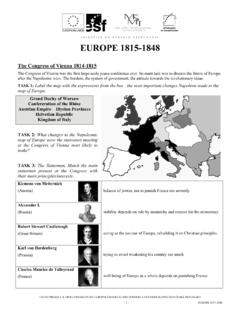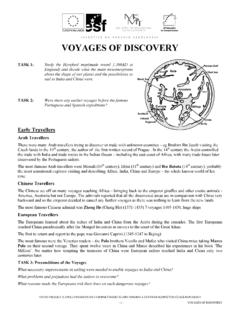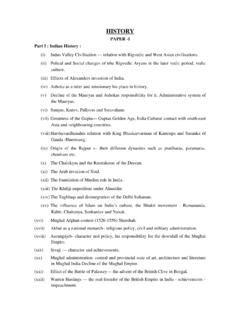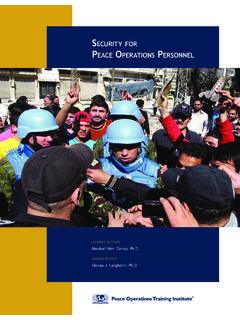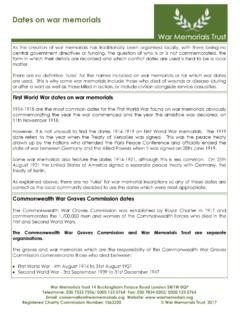Transcription of I N V E S T I C E D O R O Z V O J E VZDĚLÁVÁNÍ THE ...
1 I N V E S T I C E D O R O Z V O J E V Z D L V N TENTO PROJEKT JE SPOLUFINANCOV N EVROPSK M SOCI LN M FONDEM A ST TN M ROZPO TEM ESK REPUBLIKY - 1 - THE AMERICAN WAR OF INDEPENDENCE THE AMERICAN WAR OF INDEPENDENCE North America before 1770 Native Americans they originally came to America from _____ sometime after 30,000 BC they settled in o Central America - the Aztecs, the Maya o South America - the Incas o North America southwestern tribes the Pueblos, Navajos, Apaches southern tribes the Cherokees northeastern tribes the Hurons, Ottawas, Powhatans, Tuscaroras, the Iroquois Confederacy (five tribes, the Mohawks)
2 Discovering America Norwegian Vikings - Leif Eriksson - around 1,000 BC, archaeological evidence in _____ a sailor from Genoa _____ reached the island of San Salvador 1494 - Treaty of Tordesillas divided the new territories Amerigo Vespucci - made the public aware of the new continent for a long time Europeans called America _____ also 1497 - John Cabot explored Newfoundland 1513 - Vasco Nunez de Balboa crossed the Isthmus of Panama Colonization the conquest began at Puerco Rico by the Spanish smallpox was introduced to the New World by the conquistadors o 1519 - Hernan Cortez lands in Mexico and in 1521 destroyed the Aztec capital _____ o on his second exploration of Peru in 1529, Francisco Pizarro attacked the Inca Empire and in 1533 he destroyed the Inca Empire TASK 1: Using a historical atlas, write down the locations of.
3 Spanish colonies French colonies Dutch colonies English colonies I N V E S T I C E D O R O Z V O J E V Z D L V N TENTO PROJEKT JE SPOLUFINANCOV N EVROPSK M SOCI LN M FONDEM A ST TN M ROZPO TEM ESK REPUBLIKY - 2 - THE AMERICAN WAR OF INDEPENDENCE English colonies the first colonized territory was named after Queen Elizabeth I _____ the first settlement was established on Roanoke Island in 1584-1587 by sir _____ but the colonists mysteriously disappeared - the Lost Colony 1607 - Jamestown colony founded 1620 - Puritan refugees sailed from Plymouth on a ship called _____ and landed in Massachusetts Bay.
4 They are traditionally called the _____. During the first winter (harsh cold, scurvy, malnutrition) they were rescued by the Indians (Pokanokets) and they celebrated the first Thanksgiving. So, the Massachusetts Bay Colony was founded. another Puritan colony in Massachusetts was _____ which became infamous for the witch hunts Expansion of the English in North America the English soon started spreading and conquering other countries colonies: 1670s-1720s - wars in the south against the southern Indian tribes, conquering Florida 1689-1697 - first struggles between England and France in New England and New York 1702-1713 - Queen Anne s War - England fights France and Spain (as a part of the War of Spanish Succession) one of the last big conflicts which disturbed the colonies was the Seven Years War where the British fought the _____ Why they all fought for the colonies.
5 Economy of the colonies the American colonies produced many things the Europeans valued very much, for example: the colonies became part of the so-called Triangular trade between Europe, Africa and America AMERICA EUROPE AFRICA gold, silver, tobacco, cotton, potatoes, corn, animal skins, rice, coffee, tea, horses, cows, pigs, smallpox, some manufactured goods enslaved Africans I N V E S T I C E D O R O Z V O J E V Z D L V N TENTO PROJEKT JE SPOLUFINANCOV N EVROPSK M SOCI LN M FONDEM A ST TN M ROZPO TEM ESK REPUBLIKY - 3 - THE AMERICAN WAR OF INDEPENDENCE The Causes of the War of Independence The Thirteen colonies the original thirteen colonies which later became the founder members of the USA TASK 2: Using your atlas write down the names of the Thirteen colonies.
6 English colonial policy 1651 1696 - a series of Navigation Acts passed by the English Parliament - the colonies were to serve as a source of raw materials and a market for English goods. Also, foreign merchants were forbidden to trade with the colonies and only British ships could enter American ports (monopoly on the trade with the colonies) To keep its political, legal and economic superiority, Britain passed more limitation acts. After the Seven Years War Britain was financially exhausted and imposed higher taxes on the colonies: o the Sugar Act (1764) o the Stamp Act (1765) o the Declaratory Act (1766) - British Parliament declared its right to pass laws and impose taxes on the colonies The American colonists called this Taxation without representation.
7 O And other import taxes were introduced on - glass, lead, paper, tea, etc. All these things that the colonists to be angry and tense towards the British. to keep the colonies obedient Britain kept soldiers there 5 March 1770 the Boston Massacre In reaction to this, more British troops were sent to Boston. Later, most of the import taxes (glass, etc.) were abolished, except the duty on tea. May 1773 the Tea Act - The East India Company was given the monopoly on the American tea market. 16 December 1773 - the Boston Tea Party As a result of that, more troops arrived in Boston and martial law was imposed. Moreover, the British also reacted with the Intolerable Acts (1774) Boston harbour was closed to shipping, Massachusetts colonial charter was annulled, British colonial officers were protected from colonial courts by sending them for trial to Britain, the Americans had to house British troops in private homes etc.
8 The Americans now reacted - September 1774 - the First Continental Congress in Philadelphia - voices of opposition to the British Parliament. Here, the representatives of the Thirteen colonies, except Georgia decided to stand up and create a colonial army of the Minutemen and series of armouries ( in Concord). Another voice - Thomas Paine in his Common Sense. I N V E S T I C E D O R O Z V O J E V Z D L V N TENTO PROJEKT JE SPOLUFINANCOV N EVROPSK M SOCI LN M FONDEM A ST TN M ROZPO TEM ESK REPUBLIKY - 4 - THE AMERICAN WAR OF INDEPENDENCE The War of Independence 1775 - 1783 TASK 3: In American history, the events are called the War of Independence whereas in British textbooks you can find the American Revolution.
9 Explain the reason for the different titles. The events of the war 1775 the governor of Boston heard about the armoury at Concorde so he launched a surprise attack but the colonists were alerted soon enough April 1775 first shots were fired at Concorde and Lexington June 1775 - _____ was appointed Commander-in-Chief of the Continental Army Boston was under British siege June 1775 - battle of Bunker Hill - a victory for the British but their general Clinton wrote about it: A few more such victories would have surely put an end to British dominion in America. TASK 4: What do we call such a victory which costs us too much? July 4, 1776 at the Second Continental Congress in Philadelphia, the Declaration of Independence was signed.
10 Its author was Thomas Jefferson (it was signed by the Founding Fathers, Benjamin Franklin). We hold these truths to be self-evident, that all men are created equal, that they are endowed by their Creator with certain unalienable Rights, that among these are Life, Liberty and the pursuit of Happiness. That to secure these rights, governments are instituted among Men, deriving their just powers from the consent of the governed, That whenever any Form of Government becomes destructive of these ends, it is the Right of the People to alter or to abolish it, and to institute new Government, laying its foundation on such principles and organizing its powers in such form, as to them shall seem most likely to effect their Safety and Happiness.
